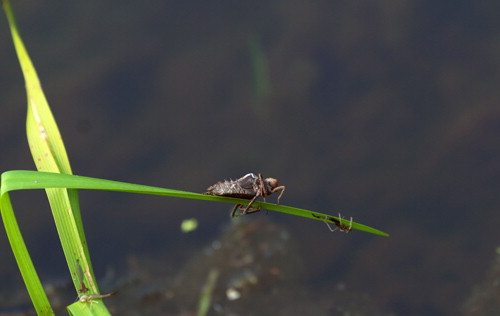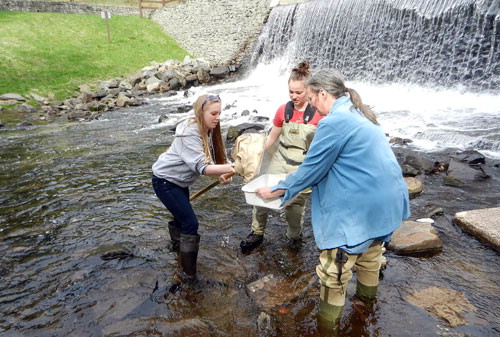Interpreting Biological Results
 In order to be involved in water quality monitoring of biological parameters, it is necessary for groups to obtain an Educational Aquatic Field Study Permit from the Pennsylvania Fish and Boat Commission- https://www.fishandboat.com/LearningCenter/Pages/AquaticFieldStudy.aspx
In order to be involved in water quality monitoring of biological parameters, it is necessary for groups to obtain an Educational Aquatic Field Study Permit from the Pennsylvania Fish and Boat Commission- https://www.fishandboat.com/LearningCenter/Pages/AquaticFieldStudy.aspx
For More Information, Contact:
Pennsylvania Fish & Boat Commission
P.O. Box 67000
Harrisburg, PA 17106-7000
(717) 705-7900
Benthic Macroinvertebrates
Benthic macroinvertebrates (or “macros” for short) are animals that lack a backbone and are large enough to be seen by the unaided eye (size >0.2-0.5mm). As a result of their habitat, macroinvertebrates are often regarded as “benthos” which refers collectively to organisms which live on, in, or near the bottom.
Freshwater benthic macroinvertebrates include the immature and adult stages of many different types of invertebrates. A freshwater benthic community may consist of the immature stages of many flies, beetles (adults and immatures), mayflies, caddisflies, stoneflies, dragonflies, aquatic worms, snails, leeches, and numerous other organisms that inhabit the stream.
Macroinvertebrates, especially immature insects, are one of the best indicia for assessing water quality. Because they are not very mobile, these organisms must be adapted to their particular ecosystem and integrate the availability of food, type of stream bottom, predators, water temperature, water velocity, and the water quality itself into their survival. Many macroinvertebrates also spend many months to years in the same location. To understand how to interpret population changes in aquatic communities, one must first understand the distribution of these organisms under natural conditions.
The following information is generally true for macroinvertebrate populations in unpolluted water. One of the most important factors for the aquatic invertebrate is the rate of flow of the water. This rate will influence the type of stream bottom, the temperature, and the amount of dissolved oxygen in the water. If the gradient is steep and the water flow is fast, as it usually is in the headwaters of a stream, then the amount of dissolved oxygen will be high, and the amount of carbon dioxide in the water will be low. The temperature of the water will be low and the stream bottom will be bedrock or large cobbles since all smaller material is carried downstream. The invertebrates in this part of the stream have many different adaptations which prevent them from being swept away. Their bodies may be flattened, such as the water penny, so that the water flows over them as they cling to a rock. The organism may be like the blackfly larva which attaches to the rocks by means of suckers or like the caddisfly larva which builds itself a case made of pebbles or wood or spins a web and attaches this case or web to the underside of rocks with silken threads. The oxygen content of the riffle (area of broken surface water) is high, the number of predators is low, and food is brought by the current. For more information on the River Continuum Concept http://www.stroudcenter.org/about/portrait/continuum.shtm
Different insects have different methods of capturing food. These methods vary from the silken net made by some caddisflies to strain food out of the current to mayflies which scrape algae off the rocks into their mouths. The riffle or rapids areas are the most productive areas in a stream and, if unpolluted, yield the greatest diversity of macroinvertebrates within the system.
 As the stream descends from the headwaters, the slope lessens. The water slows down, the temperature rises, the dissolved oxygen level may be lower, the carbon dioxide higher, and the bottom changes from gravel and sand to mud at the mouth of the stream. These changes in conditions mean a change in the kind of aquatic life that best survives. Many of the organisms found in this part of the stream are the same as those found in ponds. These include burrowing mayflies, dragonfly nymphs, damselfly nymphs, mussels, snails, leeches, backswimmers, mosquito larvae, and water striders. In the mud bottom areas, one would expect to find clams, midge larvae, fish fly larvae, alderfly larvae, water boatmen, and tubifex worms. This part of the stream, as long as it is not polluted, also has a high diversity of aquatic organisms.
As the stream descends from the headwaters, the slope lessens. The water slows down, the temperature rises, the dissolved oxygen level may be lower, the carbon dioxide higher, and the bottom changes from gravel and sand to mud at the mouth of the stream. These changes in conditions mean a change in the kind of aquatic life that best survives. Many of the organisms found in this part of the stream are the same as those found in ponds. These include burrowing mayflies, dragonfly nymphs, damselfly nymphs, mussels, snails, leeches, backswimmers, mosquito larvae, and water striders. In the mud bottom areas, one would expect to find clams, midge larvae, fish fly larvae, alderfly larvae, water boatmen, and tubifex worms. This part of the stream, as long as it is not polluted, also has a high diversity of aquatic organisms.
If pollution occurs in the stream, some organisms such as mayflies, stoneflies, water pennies, freshwater clams, caddisflies, and hellgrammites may disappear entirely as they cannot tolerate degraded water. As the pollution is broken down and diluted downstream, some of these organisms may reappear. Meanwhile, at the original site of the pollution, more tolerant species such as blackfly larvae, planaria, crayfish, and aquatic sowbugs are found. The overall diversity of organisms will be reduced. If the water is heavily polluted, you may find only the most tolerant species such as air breathing snails, rat-tailed maggots, and leeches. Even though you may find large numbers of these creatures, the overall diversity will be quite low.
To learn more about stream health, visit the following websites:
The importance of stream side forests http://www.stroudcenter.org/education/communities/buffers/index.shtm
Tips on Collecting Biological Data
Be sure to follow the same collecting technique each time your group goes to the stream, as this will allow a more accurate comparison of the data collected over time. Mark your collection site so that you can sample from the same area each time. When collecting biological data, remember to take samples from three different riffle areas each time you visit your study site.
Use the same size kick net each time you sample. Make certain no macroinvertebrates can pass under or over the screen of the kick net. Students should start “kicking” the stream bottom beginning furthest from the screen and working toward it in order to capture all macroinvertebrates. Remind students to closely examine fist-sized or larger rocks for macros clinging to them. Be sure to return these rocks to the same location in the streambed. These are living creatures that need water to breathe. Do not keep them out of the water too long.
WE Stream Biosurvey Data sheet
Tips on identification
For students (and teachers), identifying the macroinvertebrates found during sampling can be overwhelming at first. Care should be taken as to how this task is handled. Groups will vary in their degree of readiness for this task.
In the classroom, introduce your students to dichotomous keys and practice using such a key to identify major groups of macroinvertebrates. You may wish to use preserved specimens or pictures for this purpose. Once the students are familiar with keying out macroinvertebrates to orders, you may wish to stop there and simply divide members of each order into visually apparent kinds. These visually apparent kinds will most likely be sub-orders or families. For example, once members of the order Ephemeroptera (mayflies) are separated from other macroinvertebrates, students could then identify them to family level; such as, 17 Flathead Mayflies, eight Small Minnow Mayflies, and two Common Burrower Mayflies. As long as you counted the numbers (relative abundance) of different kinds of mayflies and knew the Pollution Tolerance Values (PTV) for these families, you could still calculate the diversity index for the water quality of your stream. If you are utilizing the online WE Database, each listed macroinvertebrate includes its PTV. If you click the “Show More” button, macros are listed at sub-order and family level. The system will calculate the Stream Quality Rating for you.
If you and your students are willing and able, you may want to tackle identifying aquatic insects down to sub-order, family, or even species classification by using a complete key to aquatic insects such as McCafferty’s “Aquatic Entomology: The Fisherman's and Ecologist's Illustrated Guide to Insects and Their Relatives.”
For more information on macros or for help with identification, visit the following resources:
The Carnegie Museum of Natural History Aquatic Macroinvertebrate Collection is a great new resource from the Carnegie Museum of Natural History. This site features exquisite identification photos of macros which are identified to down to family. http://macroinvertebrates.org/#/>(this site works best in Google Chrome, Safari, or Mozilla Firefox)
Macro Slideshow by Stroud Water Research Center, Pa. http://www.stroudcenter.org/research/projects/schuylkill/macroslideshow.shtm
Macro online ID Key - Stroud Water Research Center, Pa. http://www.stroudcenter.org/education/MacroKeyPage1.shtm
“Know Your Macros” PowerPoint by Michael Clapp, 2011http://www.nwnature.net/macros/docs/know_macros.pdf
Macro ID key with hand-drawn color illustrations http://www.seminole.wateratlas.usf.edu/upload/documents/Macroinvertebrate%20Keys%20Color.pdf
Mayfly Central from Purdue University http://www.entm.purdue.edu/mayfly/na-classification.php
The Izaak Walton League of America, Macro ID video https://www.youtube.com/watch?v=AV-Ul9vRyfw
Guide to Aquatic Invertebrates from the West Virginia Dept. of Environmental Protection http://www.dep.wv.gov/WWE/getinvolved/sos/Pages/Benthics.aspx



